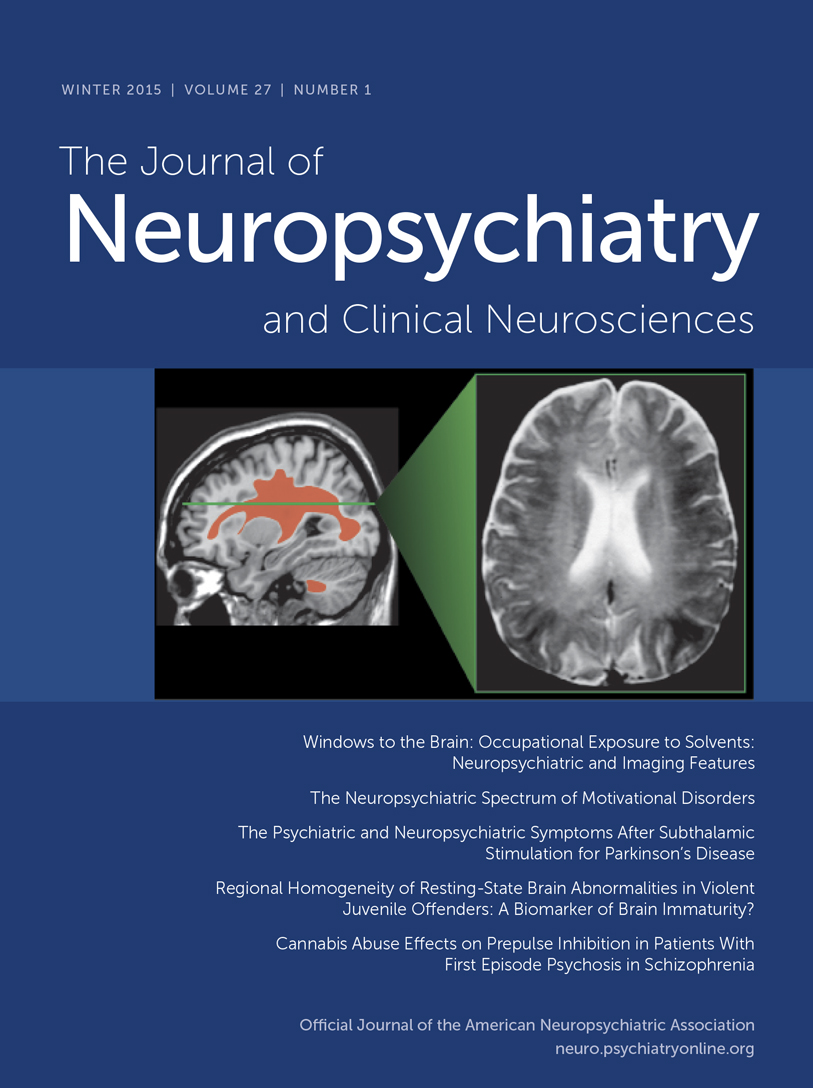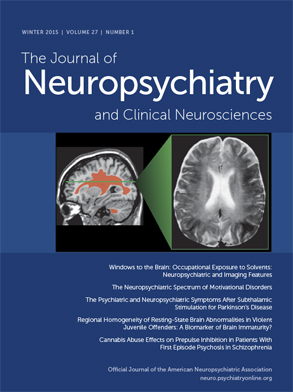Obsessive-compulsive disorder (OCD) is characterized by combinations of distressful thoughts, images or urges (obsessions), and repetitive mental or motor behaviors that are performed to reduce states of emotional discomfort or according to rigid rules (compulsions).
1 Typically, the symptoms of OCD organize themselves into five thematic clusters, including 1) contamination and washing; 2) sexual and religious; 3) aggressive and checking; 4) symmetry and ordering; and 5) hoarding.
2 In the most recent edition of the DSM diagnostic system (DSM-V), OCD is at the core of a new category termed “obsessive-compulsive and related disorders,” together with body dysmorphic disorder, hoarding disorder, trichotillomania, and excoriation disorder.
1First-line treatments of OCD include serotonin reuptake inhibitors (SRIs) and cognitive behavioral therapy involving exposure and response prevention techniques. Typically, treatment with these strategies leads to therapeutic responses in up to 60% of patients with OCD.
3 Furthermore, if partially responsive patients are treated with SRIs in combination with augmentation strategies (e.g., antipsychotics) and remain adherent to treatment on a long-term basis, as many as 90% may eventually show a beneficial response.
4 Despite these apparently favorable figures, the treatment of patients with OCD can still be challenging for several reasons, including poor treatment adherence, increased family accommodation, intolerable side effects of SRIs, lack of an appropriate response, and the development of comorbidities that can be severe and difficult to treat, such as severe depression and acute mania.
There is a pressing need to study alternative treatment strategies for patients with treatment-resistant OCD. In fact, despite the long-held perception that ECT is ineffective for OCD,
5,6 there is a handful of reports pertaining to its successful use in patients with this condition. For instance, some have advocated for ECT in an attempt to manage treatment-resistant OCD,
7 whereas others argue that a unique form of this latter condition (i.e., treatment-resistant OCD that is secondary to a primary depressive illness
8) may be particularly responsive to ECT. Some have also suggested that ECT should be reserved for the treatment of comorbid disorders in OCD rather than the OCD itself.
9 To help shed light on this complex issue, we describe the frequency of ECT use, the reasons for its prescription, and associated outcomes in patients attending a university-based OCD clinic. It is hoped that the findings will help guide future decisions regarding the potential therapeutic use of ECT in OCD.
Methods
A retrospective chart-review of 420 records of patients with OCD seen in an OCD clinic in Rio de Janeiro, Brazil, during the period between 1998 and 2013 was performed. A trained clinician (N.L.M.) reviewed the medical records and extracted information concerning demographics (age and sex), OCD-related data (i.e., age at onset and OCD predominant dimensions), concomitant psychiatric diagnosis (according to the Structured Clinical Interview for DSM-IV Axis I Disorders), pre-ECT treatment features (i.e., previous adequate drug trials), and the patterns of response to ECT [i.e., primary indications for ECT, total number and frequency of ECT sessions, and response to ECT according to Clinical Global Impression (CGI)]. No charts were excluded on the basis of lack of sufficient information. This research protocol was approved by our local institutional review board.
Discussion
Perhaps influenced by most current treatment protocols (which do not include ECT as a viable alternative in the management of OCD
3), we recommended ECT to only 1.2% of our patients. Coincidentally, all five patients who were administered ECT had a history of minimal responses to several SRI trials potentiated with antipsychotics and to exposure and response prevention. Of note, in our case series, ECT was not prescribed to primarily manage underlying treatment-resistant OCD symptoms but rather to treat the associated acute mania and/or major depressive disorder with severe suicidal ideation. Accordingly, after ECT, four patients (80%) exhibited at least a partial remission of their mood disorder symptoms and two (40%) entered full remission. These findings are in broad agreement with previous studies showing a substantial response of both acute mania
10 and depression
11 to ECT. They also add further knowledge to the ECT literature by expanding the scenarios in which acute mania and depression are treatable by this potentially valuable therapeutic tool.
Although ECT was helpful in the treatment of mood disorders in the context of OCD, it typically did not lead to any therapeutic benefit for OCD symptoms per se. In fact, it was transiently detrimental in two (40%) of our patients. Specifically, although one patient reported short-lived de novo obsessions with aggressive and sexual contents, the other described more global deterioration of his OCD symptoms. It seems that OCD differs from major depression for failing to exhibit any significant response to more diffuse treatment techniques (e.g., ECT) but showing positive responses to stimulation of specific targets of the brain, such as in the case of deep brain stimulation of the ventral striatum, the subthalamic nucleus, or the inferior thalamic peduncle.
12 Indeed, although the efficacy of ECT in depression seems to stem from its effects on hypothalamus and hippocampus,
13 neurocircuitry targets in OCD are quite different, involving the orbitofrontal cortex and ventral striatum.
It is also intriguing that, despite sharing a positive response to SRIs, depression and OCD do not exhibit the same patterns of response to ECT. Although it has been shown that SRI should be administered in higher doses and for greater periods of time in OCD compared with depression,
14 it is not clear if further treatment modifications are required to increase the effectiveness of ECT in OCD. Indeed, it has been shown that response to conventional ECT in depression does not routinely involve changes in serotonergic activity,
15 an important component of several anti-OCD treatments. Potentially, other neurostimulation techniques (such as transcranial magnetic stimulation of specific brain regions and transcranial direct current stimulation) might, at least theoretically, promote greater changes in serotonergic systems
16 or in other OCD-relevant neural structures. Therefore, given the invasiveness and costs of treatments available for patients with treatment refractory OCD (i.e., DBS and neurosurgery), it is perhaps worth investigating other noninvasive brain stimulation approaches in OCD.
In the light of our present results, it seems clear that ECT, as currently administered, should be reserved for selected cases of patients with OCD displaying severe mood disorders. In addition, and despite these indications, clinicians should consider ECT’s increased risk of worsening of OCD symptoms. In fact, when interpreting studies describing OCD patients with positive responses to ECT, one should consider that most of them were published a long time ago [even before effective treatments of OCD were available (e.g., SRIs)], included patients with atypical features (e.g., very late onset OCD),
7 and did not systematically incorporate standardized assessment methods of OCD [e.g., Yale-Brown Obsessive Compulsive Scale (YBOCS) and/or CGI].
Admittedly, our study has several limitations, including the small number of patients and other problems that are inherent to a chart review. Retrospective assessments are always dependent on the quality and completeness of the available information, which are rarely ideal. Because the indication for ECT in our patients was an intervening mood disorder, it could be argued that OCD symptom assessment was not a priority at the time of ECT administration. In fact, despite being assessed with a standardized tool (CGI), severity of OCD was not systematically evaluated with state-of-the art instruments, such the YBOCS.
Although our findings do not disprove the effectiveness of ECT in OCD, they call for further refinements in its indications. For instance, given that some OCD symptom dimensions appear to be more clearly related to depression (e.g., aggressive/checking and sexual/religious dimensions),
17 it remains to be established whether ECT or other neurostimulatory techniques are particularly effective for patients showing an specific pattern of OCD symptoms.

